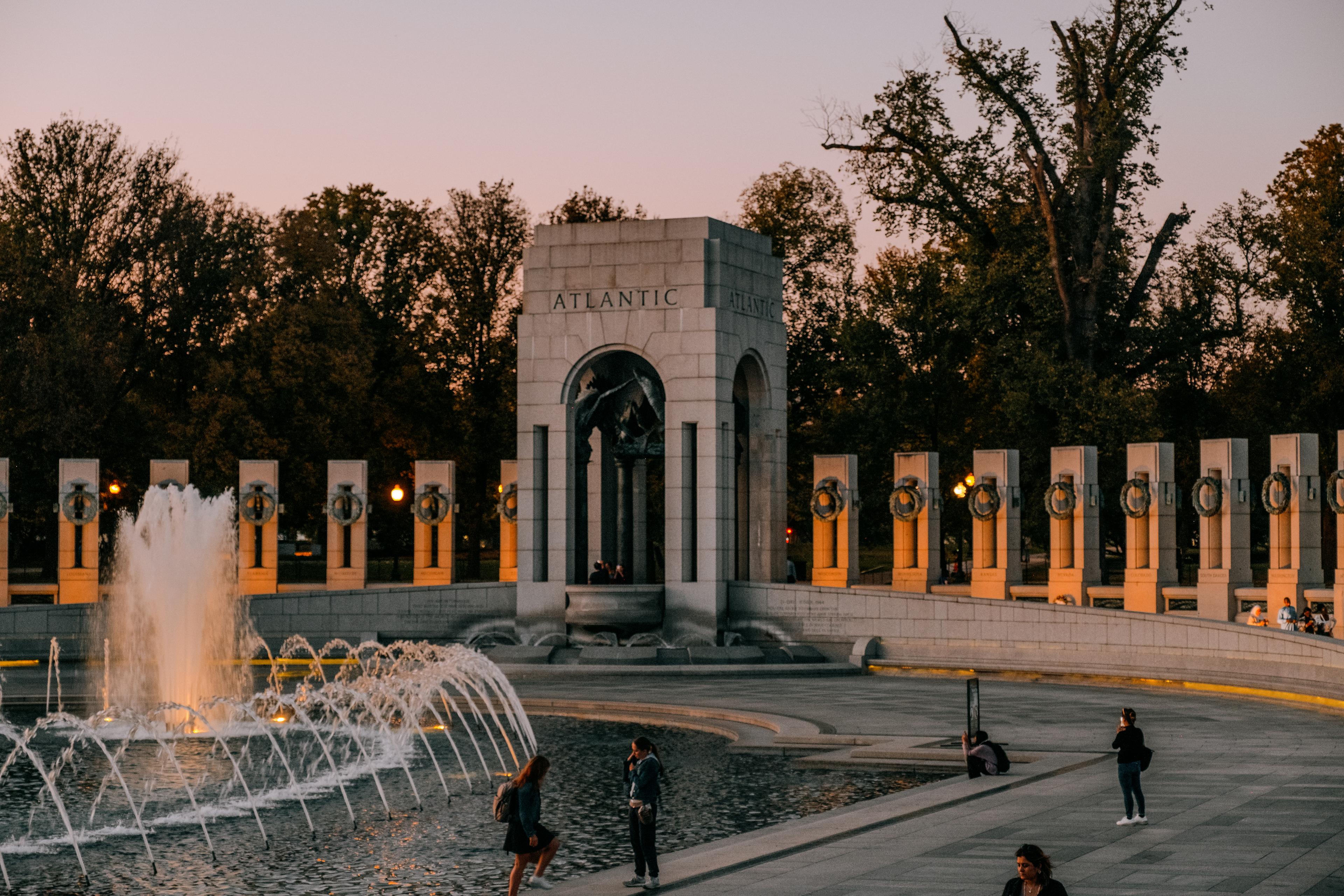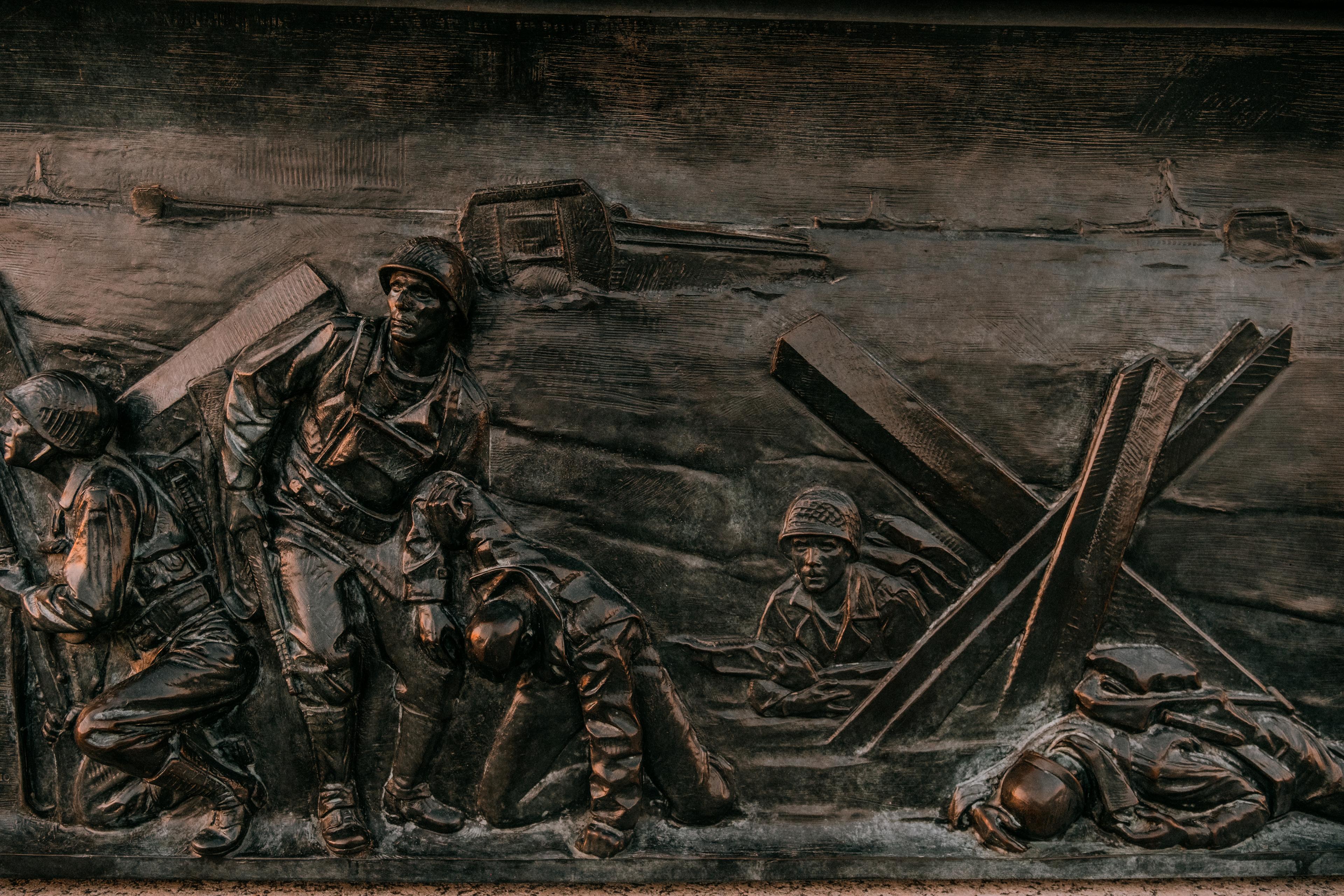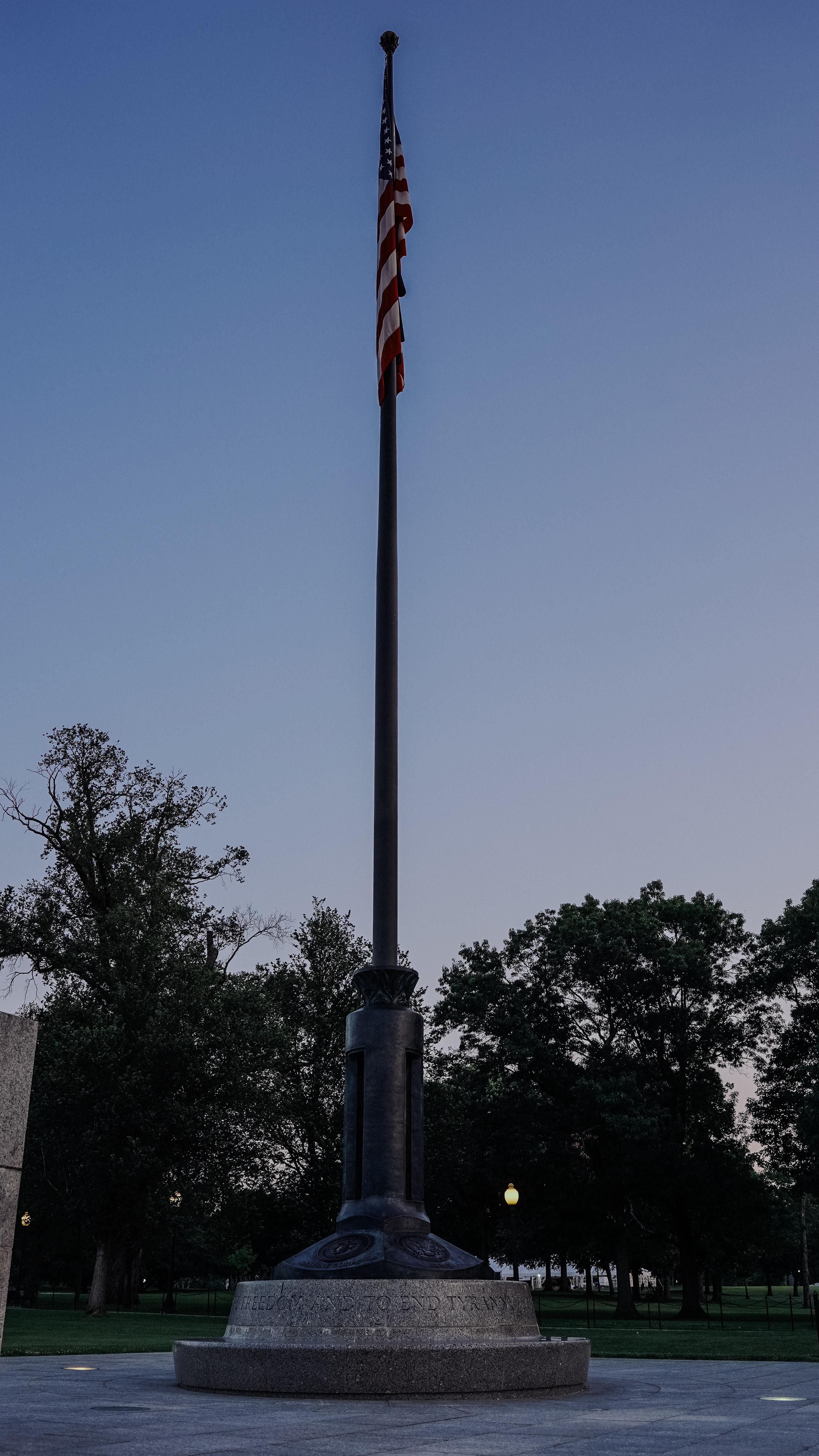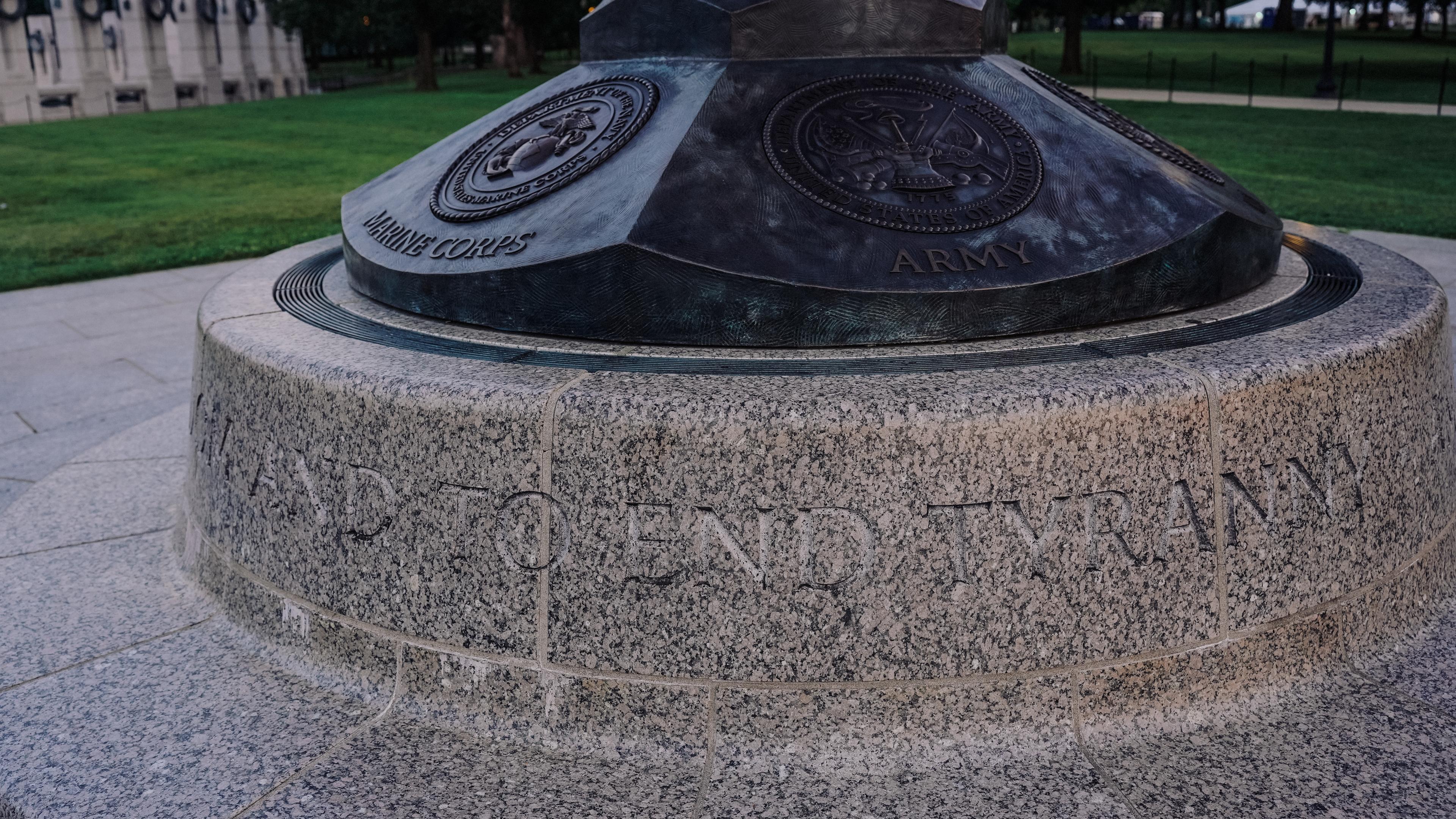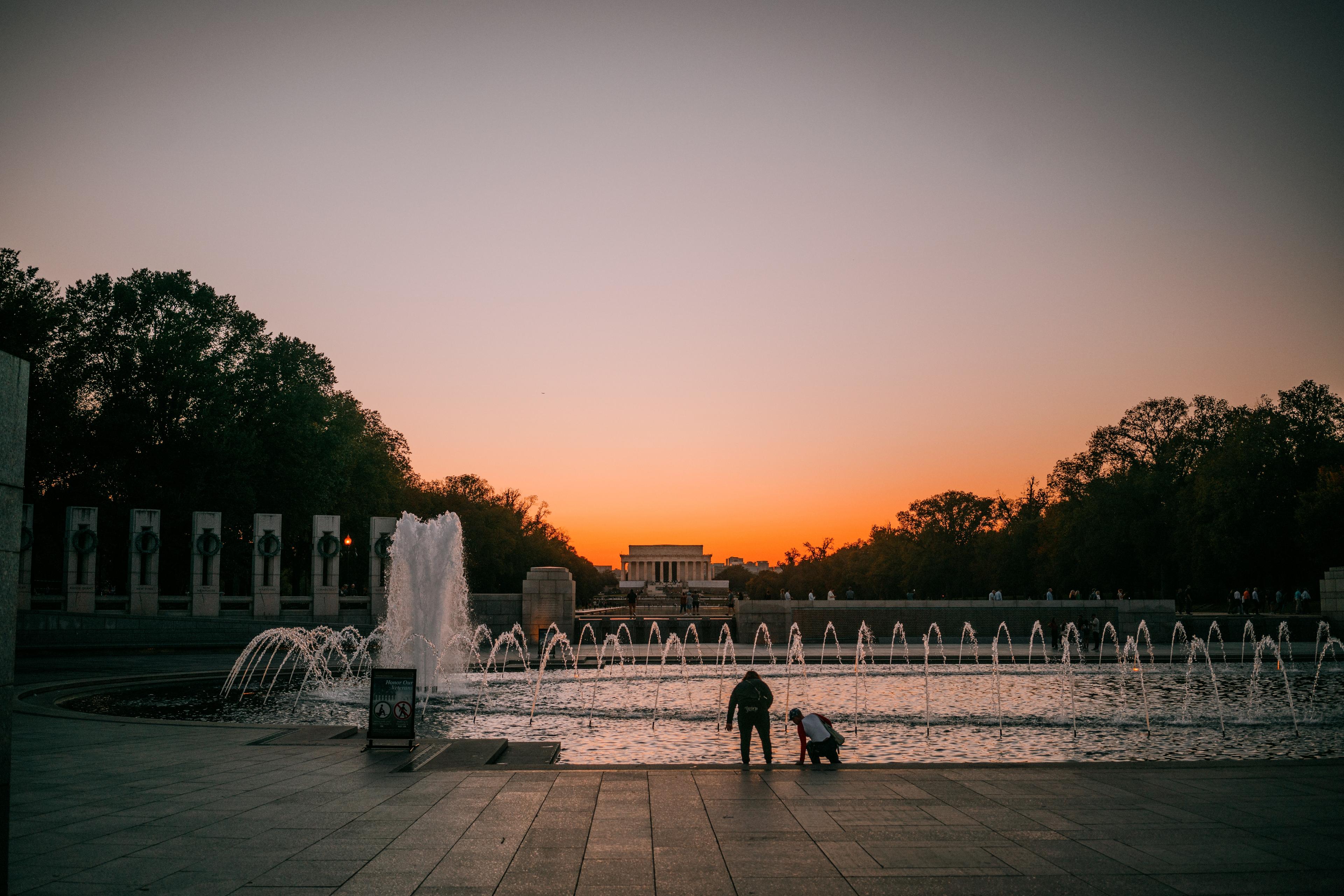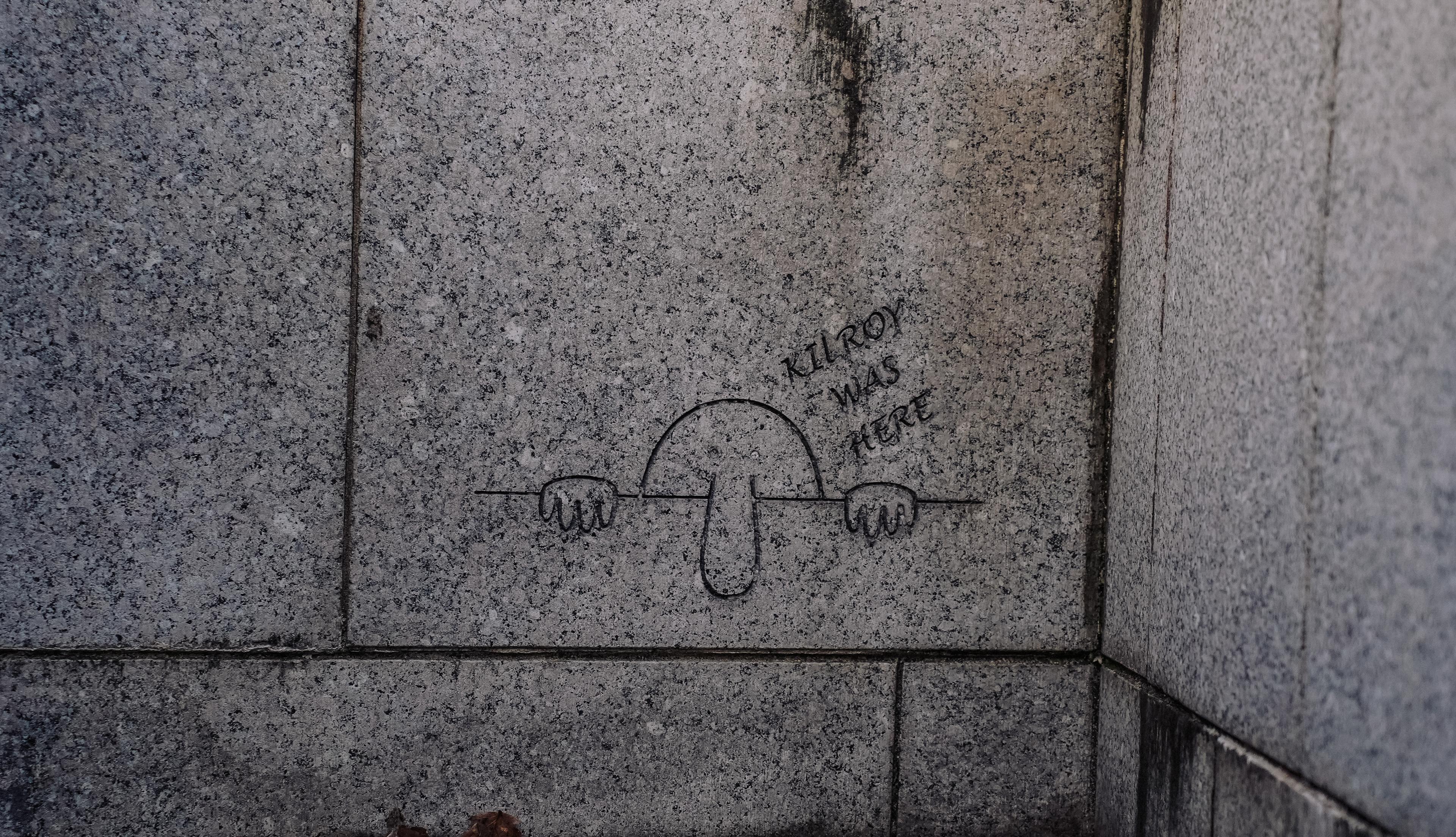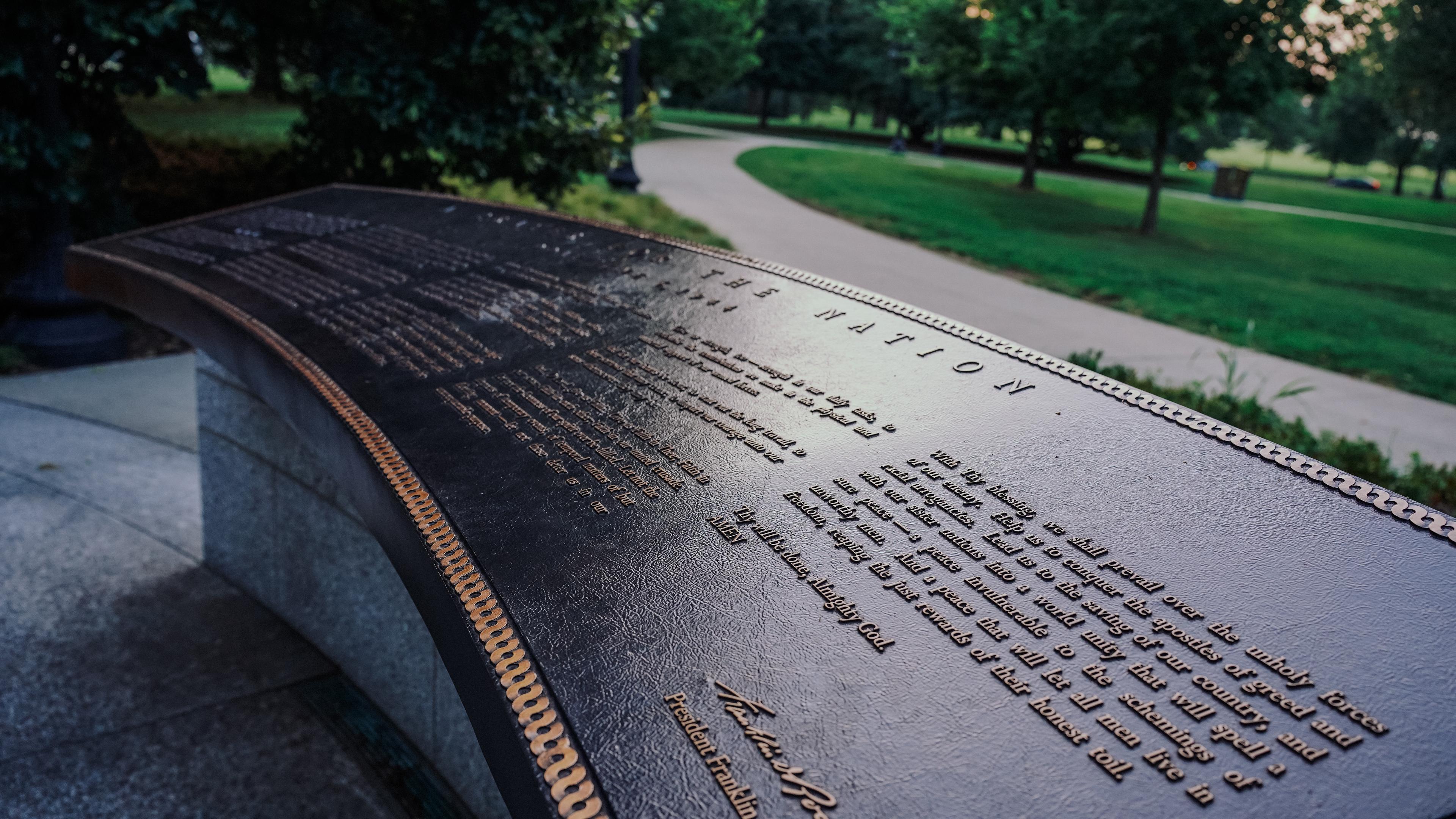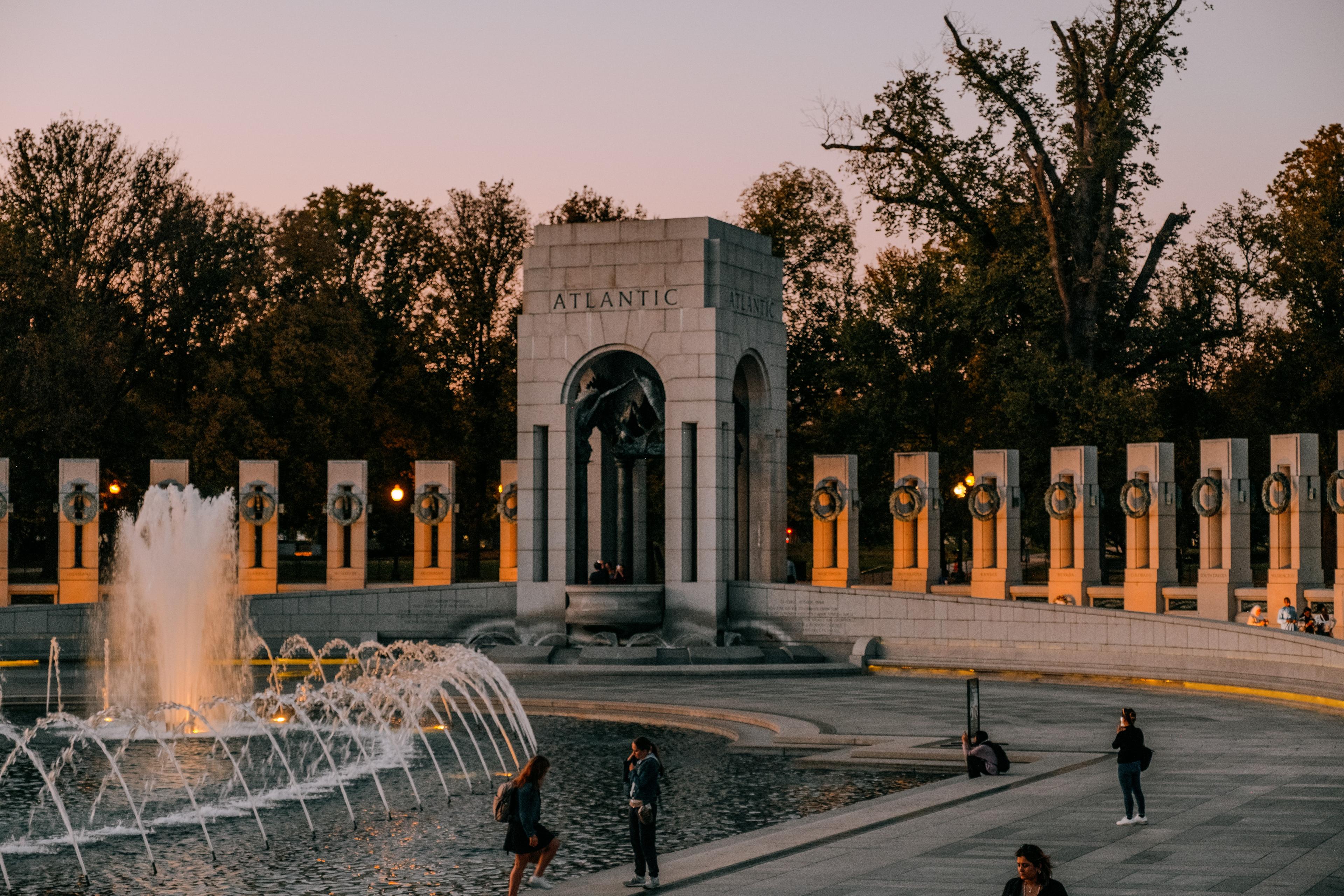
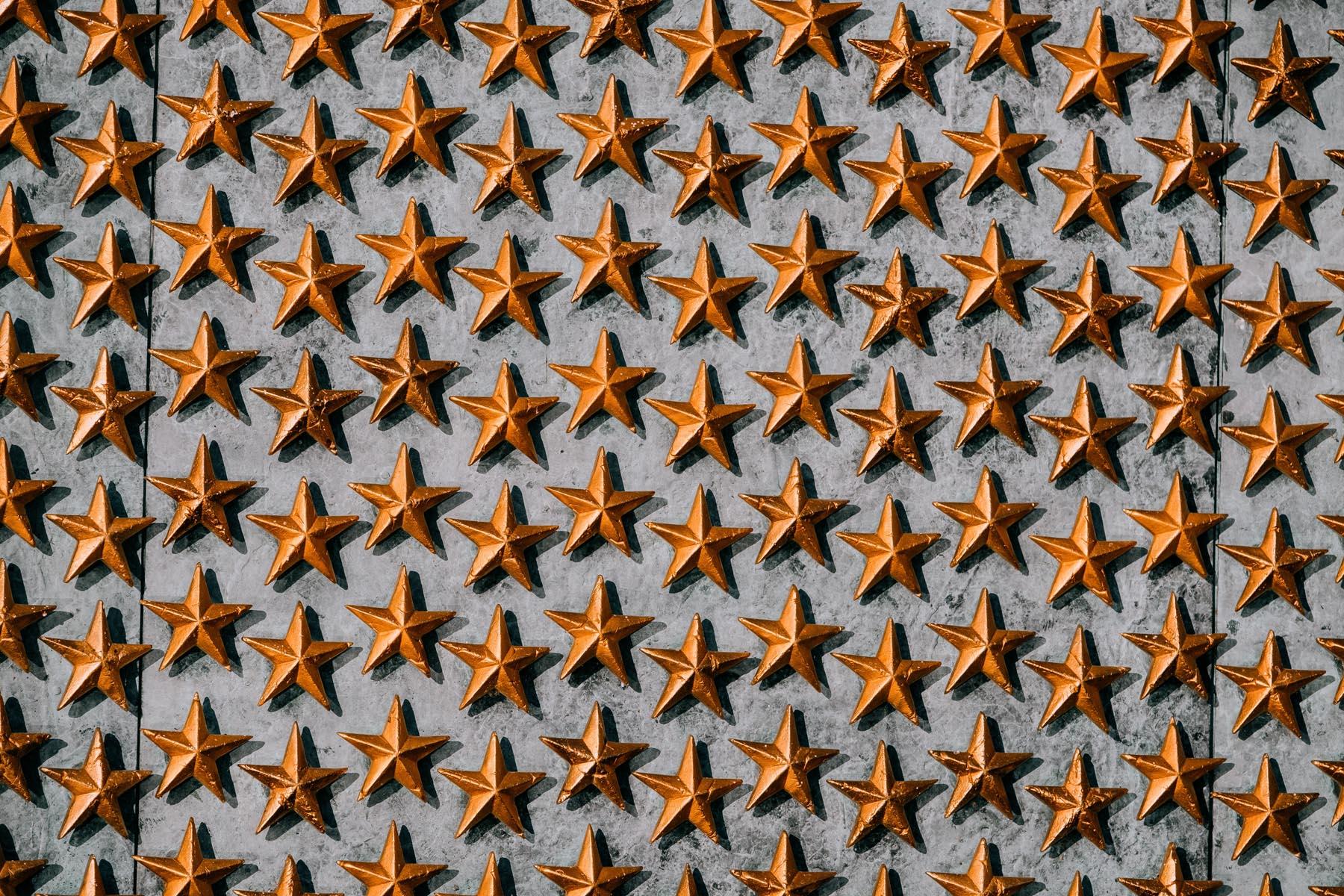
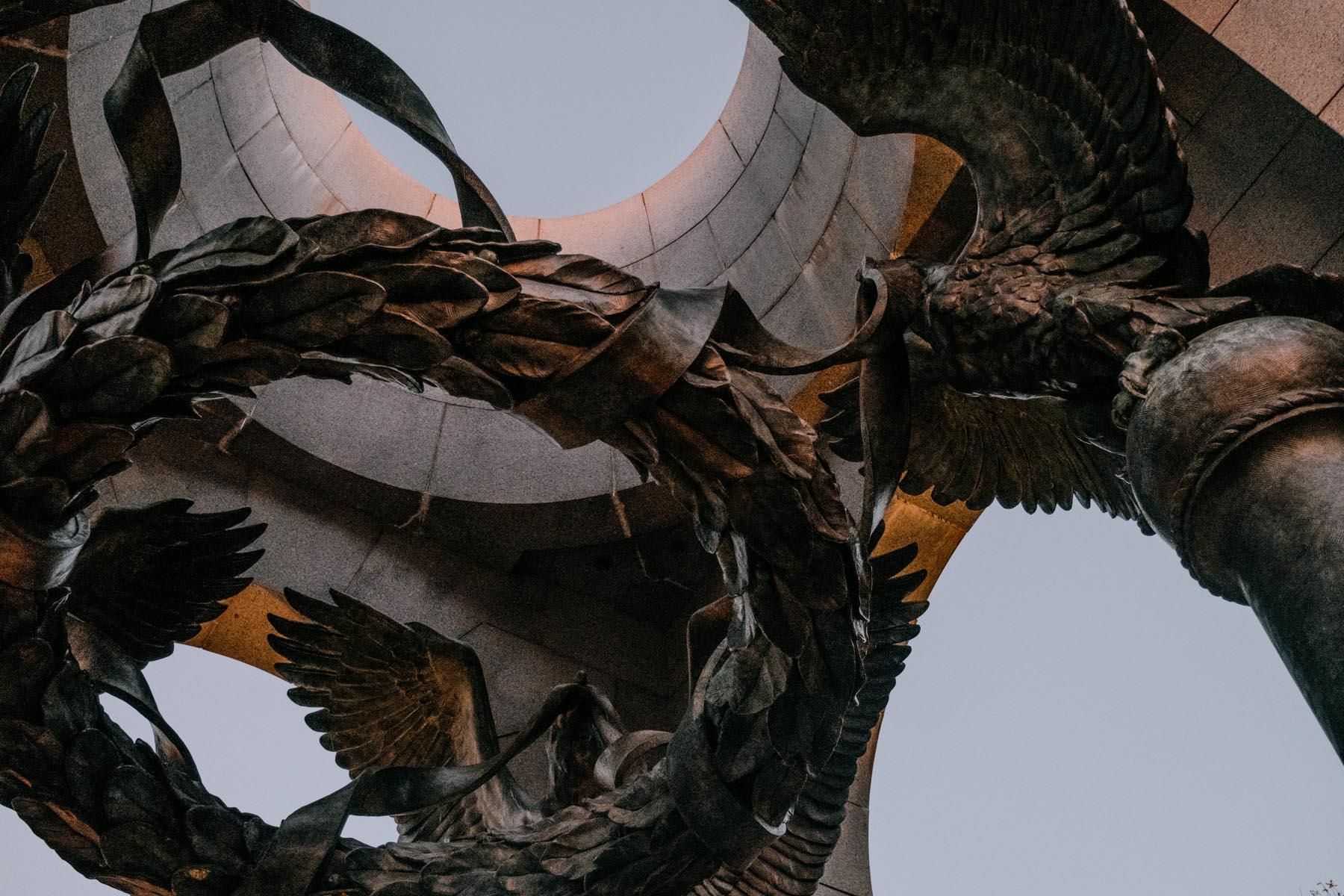
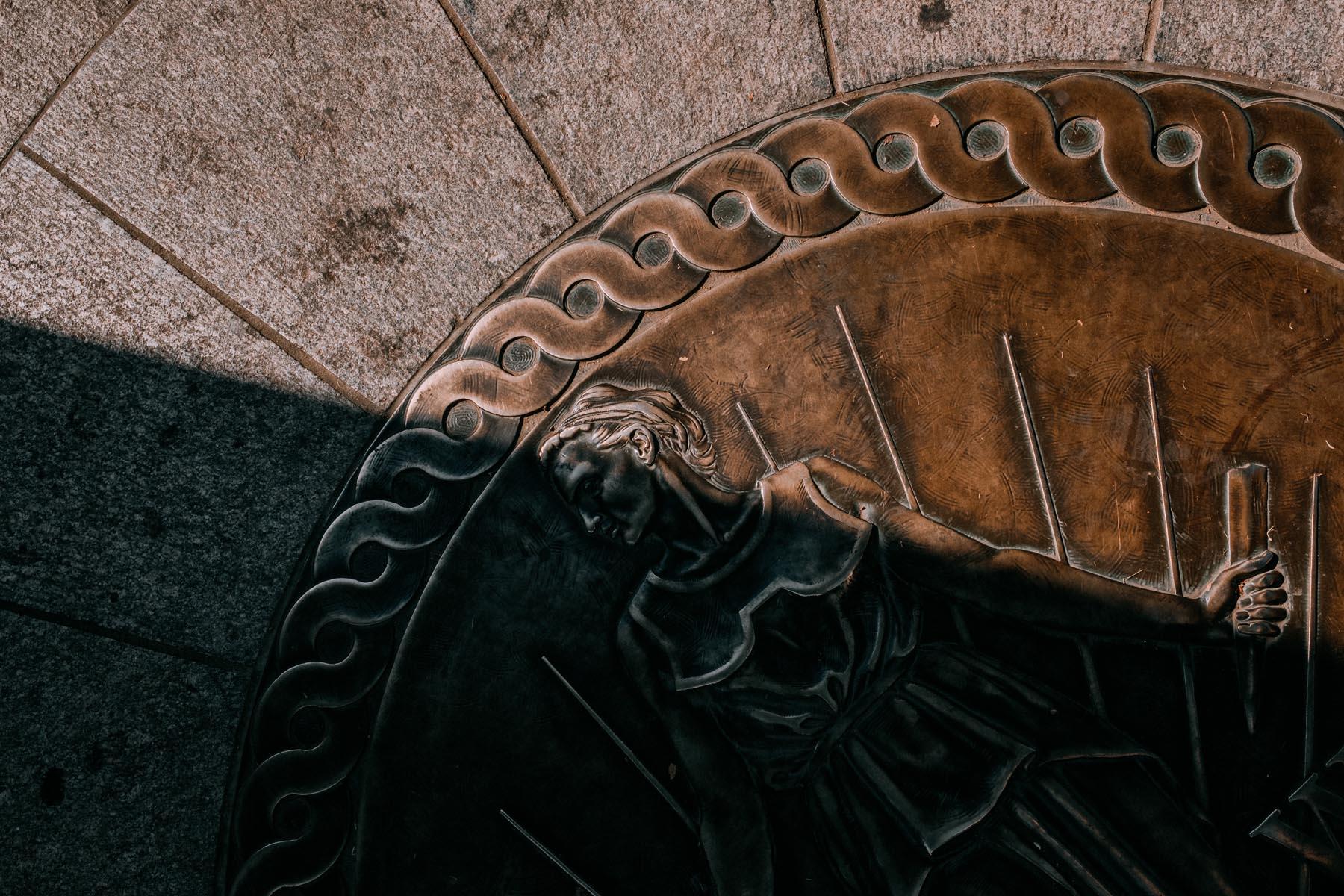

World War II Memorial
1750 Independence Avenue SW, Washington, D.C.
Amenities
- Wheelchair accessible
- Restrooms — Daytime hours vary
- Open 24 hours
During the government shutdown, open-air Memorials will generally remain accessible to visitors. Restrooms, bookstores, gift shops, and information kiosk services may be suspended. For more information, please visit: doi.gov/shutdown.
The World War II Memorial is the national memorial dedicated to Americans and American subjects who served the U.S. in World War II in the armed forces and as civilians. Designed by Austrian American architect Friedrich St. Florian, the Memorial was constructed starting in November of 2000 and opened to the public on April 29th, 2004.
The Memorial was built around the preexisting Rainbow Pool, with two “Victory Pavilion” triumphal arches flanked by fifty-six granite pillars representing the U.S. states and territories. It stands as a symbol of national unity and remembrance of the fortitude and valor of the American people during the war.

Take a virtual stroll through this National Mall site
History
Timeline of events
Japan invades Manchuria.
Italy invades Abyssinia (now Ethiopia).
Germany remilitarizes the Rhineland.
The Spanish Civil War starts—later combatant militaries of WWII use the conflict as a testing ground for weapons and tactics, especially Germany, Italy, and the USSR.
The Second Sino-Japanese War starts, later part of the Pacific Theater of WWII.
U.S. Navy Seaman First Class Freddie Falgout is killed aboard the USS Augusta when he is hit by a stray anti-aircraft shell from the Battle of Shanghai, arguably becoming the first American military casualty of WWII.
Germany annexes Austria.
Germany annexes Sudetenland.
Germany invades Poland, marking the start of the European theater in World War II.
Robert M. Losey becomes the first American military casualty of WWII’s European theater; he was an attaché during the Norwegian campaign killed by Luftwaffe bombardment while attempting to evacuate American diplomatic staff from Norway to Sweden.
Battle of France—German-Italian invasion of France.
The Battle of Britain (an air war over the UK) takes place. American volunteers see combat while flying for the RAF prior to the U.S. entry into WWII in the Eagle Squadrons.
FDR gives his “Arsenal of Democracy” speech.
The U.S. begins supplying the UK, USSR, France, the Republic of China and other Allied nations through the Lend-Lease Act.
The Flying Tigers, American pilots flying under the Republic of China flag prior to the US entry into the war, begin to arrive in East Asia.
American participation in the ongoing Battle of the Atlantic begins with the skirmish between the USS Niblack and a German U-boat. Throughout 1941 (prior to the attack on Pearl Harbor), the U.S. Navy engages in numerous battles, mainly in anti-submarine operations, despite the U.S. not yet having officially entered the war.
The U.S. invades Iceland, taking over occupation from the UK, which had taken control in May 1940 following Germany’s invasion of Denmark.
Over the course of several hours and across the International Date Line, Japan attacks Pearl Harbor, Guam, Wake Island, U.S.-occupied Philippines, British Borneo, Hong Kong, Malaya and Singapore, the Dutch East Indies, and Thailand—causing the U.S. to enter the war. President Roosevelt signs Proclamations 2525, 2526, and 2527, leading the FBI to begin arbitrarily apprehending thousands of people of German, Italian, and Japanese ancestry regardless of American citizenship.
The Duquesne Spy Ring, a network of German and pro-German spies operating in the United States, breaks up and is brought to trial. This was the largest espionage case in U.S. history ending in convictions.
Lieutenant General Joseph Stillwell is assigned to the China-Burma-India Theater, marking the United States’ major entry into the Southeast Asian theater, with such American units as Merrill’s Marauders and the Flying Tigers later becoming household names.
President Roosevelt signs Executive Order 9066, paving the way for the incarceration of more than 126,000 Japanese Americans (approximately two-thirds U.S.-born citizens), 11,500 German Americans, and 3,000 Italian Americans in incarceration camps. Additionally, about 2,200 Latin Americans of Japanese descent were deported to be held in American camps, while 22,000 Japanese Canadians were incarcerated by the Canada on recommendations by the U.S. government.
Doolittle Raid becomes the first American strike on the Japanese home islands.
The Aleutian Islands Campaign begins, marking the only land operation of WWII on North American U.S. soil. Indigenous Alaskan Aleuts are removed from their homes into “relocation” camps by the U.S. government with the U.S. military razing entire villages in a scorched earth tactic.
The Battle of Midway occurs, and the Imperial Japanese Navy’s aircraft carriers are defeated decisively.
The Guadalcanal Campaign becomes the first major Allied land offensive in the Pacific theater.
The U.S. enters the Western Front with Operation Torch, part of the North African campaign.
The Allies invade Sicily and Italy.
The Allies invade Normandy (known as D-Day).
The Auschwitz concentration camp is liberated.
Dresden is bombed.
The Battle of Iwō-Jima occurs.
Operation Meetinghouse becomes the deadliest day of the American firebombing of Tokyo, killing an estimated 100,000 people and leaving up to a million homeless, most of them civilians.
Benito Mussolini is executed along with his mistress Clara Petacci.
Adolf Hitler and wife Ava Braun commit suicide.
Dachau and subcamps are liberated.
The Battle of Okinawa, the last major battle of the Pacific theater, takes place.
A Fu-Gō balloon bomb released by the Japanese military from the mainland reaches Oregon, killing six civilians and making the only fatalities in the contiguous U.S during the war.
Victory in Europe (V-E) Day marks Germany's surrender.
The USAAF B-29 bomber “Enola Gay” drops atomic bomb “Little Boy” on Hiroshima.
The USAAF B-29 bomber “Bockscar” drops atomic bomb “Fat Man” on Nagasaki.
The Soviet-Japanese front is opened—Soviet forces invade Manchuria, South Sakhalin, and the Kuril Islands.
Japan formally surrenders, marking the end of World War II.
Congress passes legislation authorizing the building of a national World War II Memorial in Washington, D.C.
President Bill Clinton signs Public Law 103-32, authorizing previous Congressional legislation and delegating responsibility for design and construction of the monument to the American Battle Monuments Commission (ABMC).
President Clinton dedicates the World War II Memorial site on Veterans Day.
Friedrich St. Florian's preliminary design is unanimously selected from 400 entries for the memorial design contest.
President Clinton leads a ceremonial groundbreaking at the Rainbow Pool on Veterans Day.
The memorial is opened to the public.
President George W. Bush holds the memorial’s dedication ceremony.
The memorial is transferred from the ABMC to the National Park Service.
Key Features
Standing as a symbol of national unity and remembrance, the World War II Memorial boasts an impressive seventeen thousand stones and seventeen total inscriptions throughout.
However, the memorial is probably most known for its iconic fifty-six granite pillars. These encircle the north and south sides of the old Rainbow Pool, representing the forty-eight U.S. states at the time in addition to the then-territories of Alaska, American Samoa, Guam, Hawaiʻi, Philippines, Puerto Rico, and U.S. Virgin Islands and the District of Columbia. The states are inscribed in alternating order of constitutional ratification, followed by the territories. Each pillar has two wreaths—wheat represents agriculture and oak represents industry.
Other notable features include:
Reflection Questions
High school learners: Our nation’s past is complex and often provokes reflection, especially as we look to the future.
Here are a few questions to inspire deeper thinking:
- What are some design similarities and differences between the World War II Memorial and the World War I Memorial?
- Why were the Japanese attacks on other American and Allied territories/colonies that were simultaneous to Pearl Harbor noteworthy?
- What is the significance of American naval battles fought in the Atlantic Ocean before Pearl Harbor? In your opinion, at what point does a country become an active participant in war?
Educational Activities
Other Resources
Interested in learning more? The following links will provide you with additional context and information:
